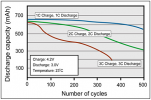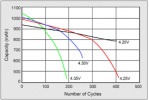"We" can't access the cell voltages directly, so there is nothing meaningful we can do to noticeably affect life and performance.
For sure we cant access direct cell voltage, but honestly we dont need to. Charging slower is all we can do, and it helps. It probably wont double you battery life, but hell, it might. I think 20-30% longer life is safe bet.
And while we cant access cell voltages directly, when plugged in turned on drone, the drone actually reports cell voltage to the app (where you can see it in battery info). Tho I remember reading a comment about BMS actually reporting single voltage of the
2s battery, and its just the app dividing it by two and showing it as real values. I have no idea about how much truth is in this, but makes one wonder. (iirc it was discussing
mini 2 batteries, might have changed with
mini 3)
Do we conclude this a full charge, every electron possible that the cell will accept has been shoved in there, so if we don't discharge soon damage will occur?
The cell is not a bottle with a clear brim that serves as the upper limit of how much water it can hold. Better analogy would be a sponge. There is theoretical limit of how much energy a cell can store, but given that each cell is physically different and every cell is not 100% perfect (every atom at its supposed position), the actual limit is lower. But even approaching this therotical maximum would destroy any cell before that maximum would even be reached. The physical maximum is lower, but that doesnt mean you want to approach even this physical maximum..
Damage happens even during regular use. Even if you are charging super slowly from 50 to 51%, the battery is suffering irreversible damage. The thing is, during some states, the damage a battery is suffering is much, much,
much lower than during other states. If you only use the middle 50% of the battery (25-75% range), you can get multiple times more cycles (even when we count two 25->75% charges as one cycle) from the cell, compared to cell being cycled from 0% to 100%.
The closer you approach cell limit, the exponentially more damage the cell is sustaining. The 100% charge state is human selected voltage level (physical properties of a cell are taken into account) that the cells get charged to. You could charge the cell to the higher voltage levels, and it would hold more energy, but would degrade way faster. You could charge it less, and it would last longer. Selected 100% voltage is a tradeoff between longterm battery longetivity and light-time of each flight. Everybody wants as long flight times as possible, so DJI is incentivized to squeeze as much from the batteries as possible. Using the 100% of what these batteries are programmed to give us is already on the very punishing end for the batteries, its best to never use the battery to 0% not only from the standpoint of loosing the drone. On the other side of the charge limit, stopping charging at 80% would help prolong the battery longetivity trendemously, but lets be honest, who of us would bother to vigilantly watch over batteries on charger to unplug them prematurely and then loose another 5+ minutes of flight time. I certainly dont, I understand and accept that the batteries are being pushed to the limits, and probably wont last much longer than 300 cycles. And thats okay. But when the matter of choice between slow and fast charging is just using less powerfull wall adapter (if Im not in a hurry to charge asap to fly right away), it can only help the battery last longer.
I am not saying everyone is doing it wrong, I am not saying everyone is stupid for doing it the other way, and I am not persuading anyone to change their charging habbits. All I am doing is laying down facts about battery tech, how treating the battery affects its performance over its lifetime, and thus allowing people to make more informed decisions on how they want to treat their batteries.
@MaximusCZ, when a DJI battery indicates full charge, are the lipo cells at full charge? 95%? 90%? Do you know?
To adress this speciffically: There is no true 100%. Its a choice (that DJI is making for us) of where to draw a line and saying "stop charging beyond this point, its not worth it". You can check the second graph at the end of
this post of mine to see that charging charging the battery to 4.35V per cell yields more energy stored (line starts higher) than charging to 4.25V, but is damaging the battery to the degree where in less than 100 cycles, the maximum charge a battery can hold drops below what a battery charged to 4.25V would hold.












